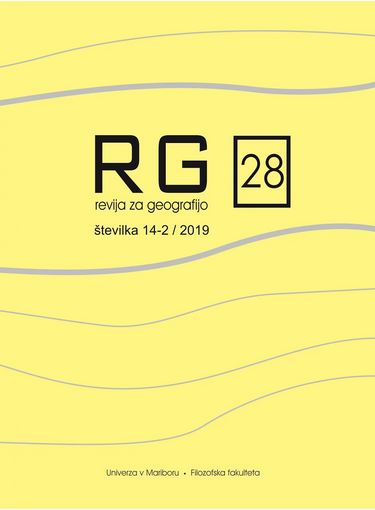Trends of minimum temperatures in Maribor
DOI:
https://doi.org/10.18690/rg.14.2.3649Keywords:
climate changes, minimal temperatures, MariborAbstract
The article analyses the minimum temperature trends at the Maribor-Tabor meteorological station in the period 1961-2019. The minimum temperatures rise at a higher rate than the maximum temperatures, which is a result of the interaction of global climate change and the intensification of the urban heat island phenomenon. Trends in the number of days with minimum temperatures below -10.0 °C, the number of days with minimum temperatures below 0.0 °C (cold days), the number of days with maximum temperatures below 0.0 °C (ice days) and the number of days with minimum temperatures above 20.0 °C (tropical nights) are also analysed. Data show a markedly lower number of days with a minimum temperature below -10.0 ° C and a higher number of tropical nights. The frequency of tropical nights is increasing at an exponential rate. These trends otherwise affect the shortening of the heating season and lower heating costs in winter, but in summer, due to increased stress, reduce the quality of the living environment. Thus, people with health issues, the elderly, children and pregnant women are additionally exposed to heat stress, which may even increase mortality.
Downloads
References
Buguet, A., 2007: Sleep under extreme environments: effects of heat and cold exposure, altitude, hyperbaric pressure and microgravity in space. Journal for Neurological Science. Nov 15;262(1-2):145-52. https://doi.org/10.1016/j.jns.2007.06.040
Douglas, I., James, P., 2015: Urban Ecology. An Introduction. Routledge. London.
Easterling, D.R, Horton, B., Jones, P.D., Peterson, T.C., Karl, T.R., Parker, D.E., Salinger, M.J., Razuvayev, V., Plummer, N., Jamason, P., Folland, C.K., 1997: Maximum and Minimum Temperature Trends for the Globe. Science. Vol. 277. No. 5324. http://dx.doi.org/10.1126/science.277.5324.364
EEA, 2012: Urban adaptation to climate change in Europe, EEA Report No.2/ 2012.
Forman, R.T.T., 2016: Urban Ecology. Science of Cities. Cambridge University Press. Cambridge.
Krakauer, N.Y., 2018: Shifting Hardines Zones: Trends in Annual Minimum Temperatures. Climate. Vol. 15, No. 6. https://doi.org/10.3390/cli6010015
Minimum home temperature thresholds for health in winter, 2014. Public Health England. Wellington House. London.
Oke, T.R., Mills, G., Christen, A., Voogt, J.A., 2017: Urban Climates. Cambridge University Press. Cambridge. https://doi.org/10.1017/9781139016476
Parson, K., 2014: Human Thermal Envirnments. The Effects of Hot, Moderate, and Cold Environments on Human Health, Comfort, and Performance. CRC Press. London. https://doi.org/10.1201/b16750
Shouraseni, S.R., Fei, Y., 2009: Trends in Extreme Temperatures in Relation to Urbanization in the Twin Cities Metropolitan Area, Minnesota. Journal of Applied Meteorology and Climatology. Volume 48 No. 3. http://dx.doi.org/10.1175/2008JAMC1983.1
Urban Atlas. Copernicus Land Monitoring Service, 2019.
Vose, R.S., Easterling, D.R., Gleason, B., 2005: Maximum and minimum temperature trends for the globe: An update through 2004. Geophysical Research Letters. Volume 32, Issue 23. American Geophysical Union. https://doi.org/10.1029/2005GL024379
Žiberna, I. 1999: Temperaturni obrat v hriboviti Sloveniji. V: GOSAR, Anton (ur.), KUNAVER, Jurij (ur.). Sonaravni razvoj v slovenskih Alpah in sosedstvu = Sustainable development in the Slovenian Alps and its neighbouring regions, (Dela, ISSN 0354-0596, 13). Ljubljana: Oddelek za geografijo Filozofske fakultete. 1999. https://doi.org/10.4312/dela.13.237-248
Žiberna, I., 2006: Trendi temperatur zraka v Mariboru kot posledica razvoja mestnega toplotnega otoka. Revija za geografijo, 2006, 1, št. 1.
Žiberna, I., Ivajnšič, D., 2018: Vročinski valovi v Mariboru v obdobju 1961-2018. Revija za geografijo, 2018, 13, št. 26.
Downloads
Published
Issue
Section
License
Copyright (c) 2019 Igor Žiberna, Danijel Ivajnšič

This work is licensed under a Creative Commons Attribution 4.0 International License.
